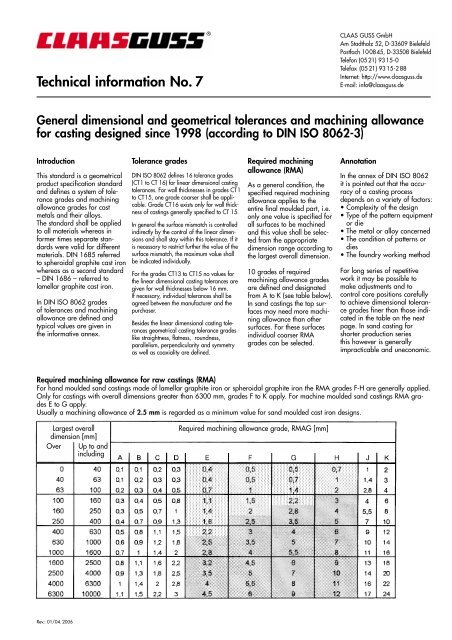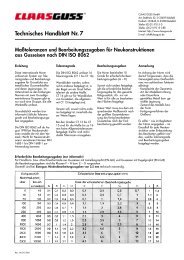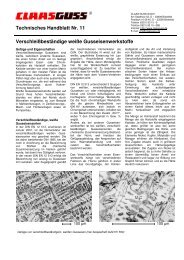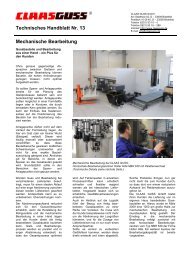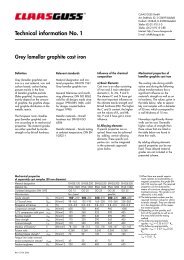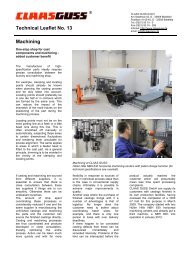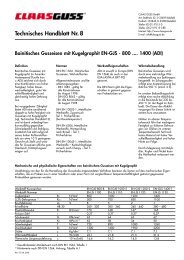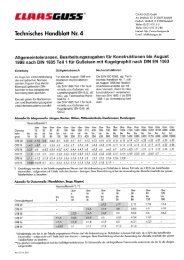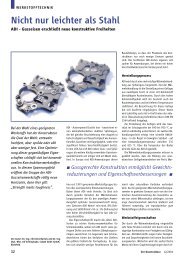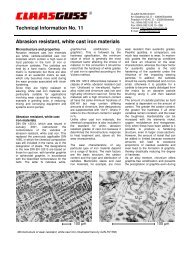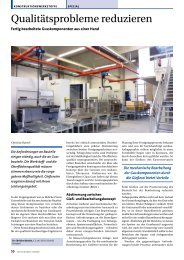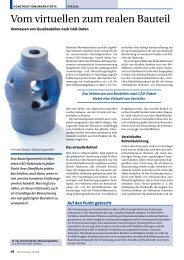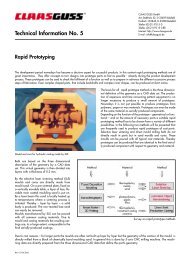Technical information No. 7 - CLAAS GUSS GmbH
Technical information No. 7 - CLAAS GUSS GmbH
Technical information No. 7 - CLAAS GUSS GmbH
Create successful ePaper yourself
Turn your PDF publications into a flip-book with our unique Google optimized e-Paper software.
<strong>Technical</strong> <strong>information</strong> <strong>No</strong>. 7<br />
®<br />
<strong>CLAAS</strong> <strong>GUSS</strong> <strong>GmbH</strong><br />
Am Stadtholz 52, D-33609 Bielefeld<br />
Postfach 100845, D-33508 Bielefeld<br />
Telefon (05 21) 93 15-0<br />
Telefax (05 21) 93 15-2 88<br />
Internet: http://www.claasguss.de<br />
E-mail: info@claasguss.de<br />
General dimensional and geometrical tolerances and machining allowance<br />
for casting designed since 1998 (according to DIN ISO 8062-3)<br />
Introduction<br />
This standard is a geometrical<br />
product specification standard<br />
and defines a system of tolerance<br />
grades and machining<br />
allowance grades for cast<br />
metals and their alloys.<br />
The standard shall be applied<br />
to all materials whereas in<br />
former times separate standards<br />
were valid for different<br />
materials. DIN 1685 referred<br />
to spheroidal graphite cast iron<br />
whereas as a second standard<br />
– DIN 1686 – referred to<br />
lamellar graphite cast iron.<br />
In DIN ISO 8062 grades<br />
of tolerances and machining<br />
allowance are defined and<br />
typical values are given in<br />
the informative annex.<br />
Tolerance grades<br />
DIN ISO 8062 defines 16 tolerance grades<br />
(CT1 to CT 16) for linear dimensional casting<br />
tolerances. For wall thicknesses in grades CT1<br />
to CT15, one grade coarser shall be applicable.<br />
Grade CT16 exists only for wall thickness<br />
of castings generally specified to CT 15.<br />
In general the surface mismatch is controlled<br />
indirectly by the control of the linear dimensions<br />
and shall stay within this tolerance. If it<br />
is necessary to restrict further the value of the<br />
surface mismatch, the maximum value shall<br />
be indicated individually.<br />
For the grades CT13 to CT15 no values for<br />
the linear dimensional casting tolerances are<br />
given for wall thicknesses below 16 mm.<br />
If necessary, individual tolerances shall be<br />
agreed between the manufacturer and the<br />
purchaser.<br />
Besides the linear dimensional casting tolerances<br />
geometrical casting tolerance grades<br />
like straightness, flatness, roundness,<br />
parallelism, perpendicularity and symmetry<br />
as well as coaxiality are defined.<br />
Required machining<br />
allowance (RMA)<br />
As a general condition, the<br />
specified required machining<br />
allowance applies to the<br />
entire final moulded part, i.e.<br />
only one value is specified for<br />
all surfaces to be machined<br />
and this value shall be selected<br />
from the appropriate<br />
dimension range according to<br />
the largest overall dimension.<br />
10 grades of required<br />
machining allowance grades<br />
are defined and designated<br />
from A to K (see table below).<br />
In sand castings the top surfaces<br />
may need more machining<br />
allowance than other<br />
surfaces. For these surfaces<br />
individual coarser RMA<br />
grades can be selected.<br />
Annotation<br />
In the annex of DIN ISO 8062<br />
it is pointed out that the accuracy<br />
of a casting process<br />
depends on a variety of factors:<br />
• Complexity of the design<br />
• Type of the pattern equipment<br />
or die<br />
• The metal or alloy concerned<br />
• The condition of patterns or<br />
dies<br />
• The foundry working method<br />
For long series of repetitive<br />
work it may be possible to<br />
make adjustments and to<br />
control core positions carefully<br />
to achieve dimensional tolerance<br />
grades finer than those indicated<br />
in the table on the next<br />
page. In sand casting for<br />
shorter production series<br />
this however is generally<br />
impracticable and uneconomic.<br />
Required machining allowance for raw castings (RMA)<br />
For hand moulded sand castings made of lamellar graphite iron or spheroidal graphite iron the RMA grades F-H are generally applied.<br />
Only for castings with overall dimensions greater than 6300 mm, grades F to K apply. For machine moulded sand castings RMA grades<br />
E to G apply.<br />
Usually a machining allowance of 2.5 mm is regarded as a minimum value for sand moulded cast iron designs.<br />
Largest overall<br />
dimension [mm]<br />
ooOver Up to and<br />
including<br />
Required machining allowance grade, RMAG [mm]<br />
4<br />
5,5<br />
7<br />
2<br />
3<br />
4<br />
Rev.: 01/04. 2006
®<br />
Linear dimensional casting tolerances<br />
Unless specified differently the casting tolerances shall be symmetrically disposed with respect to the nominal dimension.<br />
Due to technical reasons for cast iron – especially for short-series or single-production – the tolerance grades CT8 shall be treated as special tolerance grade. For<br />
guidance the out-dated standards DIN 1685 and DIN 1686 may still be used.<br />
<strong>No</strong>minal dimensions related<br />
to the moulded part [mm]<br />
o Over Up to and<br />
including<br />
Dimensional casting tolerance grades, DCTG [mm]<br />
Geometrical casting tolerance for cast iron materials (informative)<br />
Long-series production raw castings<br />
Method<br />
Grey lamellar cast iron<br />
(EN-GJL-...)<br />
Sand cast, machine moulded DCTG 8-12<br />
Spheroidal graphite<br />
cast iron (EN-GJS-...)<br />
Short-series or single-production raw castings<br />
Method<br />
Sand cast, hand moulded<br />
(Clay bonded)<br />
Sand cast, hand moulded<br />
(Chemically bonded)<br />
Grey lamellar cast iron<br />
(EN-GJL-...)<br />
DCTG 13 – 15<br />
DCTG 11 – 14<br />
Spheroidal graphite<br />
cast iron (EN-GJS-...)


